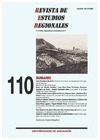Please use this identifier to cite or link to this item:
https://accedacris.ulpgc.es/jspui/handle/10553/41381
| Title: | Análisis histórico-geográfico del poblamiento en Gran Canaria | Other Titles: | Historical and geographical analysis of the population settlements in Gran Canaria | Authors: | Ramón Ojeda, Antonio A. Morales, Alejandro González |
UNESCO Clasification: | 5206 Características de la población 2505 Geografía |
Keywords: | Patrón espacial Poblamiento Etapas históricas Sectores económicos Spatial pattern, et al |
Issue Date: | 2017 | Journal: | Revista de Estudios Regionales | Abstract: | El poblamiento en Canarias es un tema escasamente trabajado desde una perspectiva global que aborde su análisis espacial. Este trabajo reflexiona sobre la validez de los censos de población y nomenclátores como fuentes básicas de estudio y analiza el poblamiento de la isla de Gran Canaria desde una perspectiva histórico-geográfica por entender que el factor histórico es condicionante del actual patrón de distribución del poblamiento. Se concluye advirtiendo que en Gran Canaria existen al menos tres etapas de poblamiento, cada una de las cuales es resultado y herencia de la anterior. La influencia del medio ha ido viéndose reducida según se producían los avances tecnológicos y, sobre todo, los cambios económicos. En efecto, la base económica ha contribuido a definir cada una de las etapas de poblamiento consideradas: prehispánica, agraria y moderna. The topic of the settlement in The Canary Islands has been scantily addressed, especially from the optics of its spatial analysis. This article reflects on about the validity of Population censuses and nomenclatores as basic sources of studies. Besides, this article also analyses the peopling of Gran Canaria from a historical and geographical perspective because the historical factor is fundamental to recognized and understand its present spatial pattern. It has been concluded that in Gran Canaria there are at least three stages of settlement, each of which is the result of the previous one. The influence of the environment has been reduced for technological advances while economic changes have taken place. In fact, the economic base has contributed to define each of the stages of population considered: pre-Hispanic, agrarian and modern. |
URI: | https://accedacris.ulpgc.es/handle/10553/41381 | ISSN: | 0213-7585 | Source: | Revista de Estudios Regionales[ISSN 0213-7585], p. 197-225 |
| Appears in Collections: | Reseña |
SCOPUSTM
Citations
1
checked on Jun 8, 2025
WEB OF SCIENCETM
Citations
1
checked on Feb 25, 2024
Page view(s)
92
checked on May 11, 2024
Download(s)
64
checked on May 11, 2024
Google ScholarTM
Check
Share
Export metadata
Items in accedaCRIS are protected by copyright, with all rights reserved, unless otherwise indicated.
